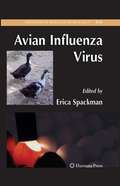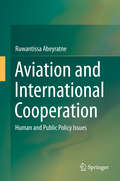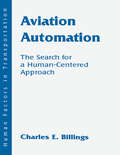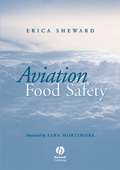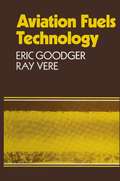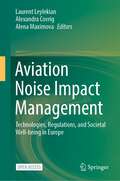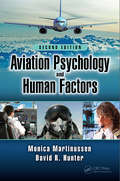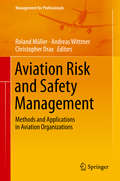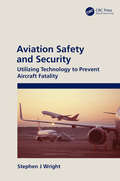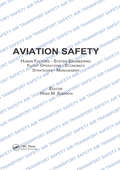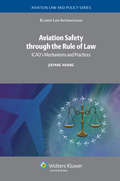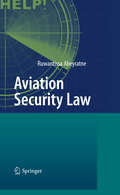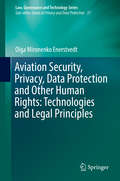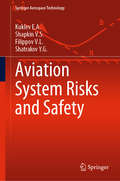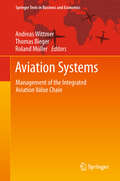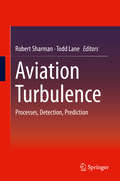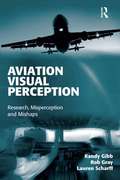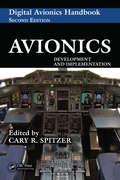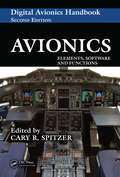- Table View
- List View
Avian Influenza Virus (Methods in Molecular Biology #436)
by Erica SpackmanWith the growing global fear of a major pandemic, avian influenza (AI) virus research has greatly increased in importance. In Avian Influenza Virus, an expert team of researchers and diagnosticians examine the fundamental, yet essential, virological methods for AI virus research and diagnostics as well as some of the newest molecular procedures currently used for basic and applied research. They present exciting, cutting-edge new methods that focus both on studying the virus itself and on work with avian hosts, an area greatly lacking in research.
Aviation and International Cooperation: Human and Public Policy Issues
by Ruwantissa AbeyratneThis book addresses an essential gap in the regulatory regime, which provides legislation, statements and guidelines on airlines, airports, air navigation services providers and States in the field of aviation, but is notably lacking when it comes to the rights of the airline passenger, and the average citizen who is threatened by military air strikes. It addresses subjects such as international resolutions on human rights and other human rights conventions related to aviation that impact both air transport consumers and people on the ground who are threatened by air strikes through drone attacks; disabled and obese airline passengers; compensation for delayed carriage and the denial of carriage; noise and air pollution caused by aviation and their effects on human health and wellbeing; prevention of death or injury to passengers and attendant compensatory rights; risk management; relief flights; and racial profiling. These subjects are addressed against the backdrop of real case studies that include but are not limited to instances of drone attacks, and contentious flights in the year 2014 such as MH 370, MH 17 and QZ 8501.
Aviation Automation: The Search for A Human-centered Approach (Human Factors in Transportation)
by Charles E. BillingsThe advent of very compact, very powerful digital computers has made it possible to automate a great many processes that formerly required large, complex machinery. Digital computers have made possible revolutionary changes in industry, commerce, and transportation. This book, an expansion and revision of the author's earlier technical papers on this subject, describes the development of automation in aircraft and in the aviation system, its likely evolution in the future, and the effects that these technologies have had -- and will have -- on the human operators and managers of the system. It suggests concepts that may be able to enhance human-machine relationships in future systems. The author focuses on the ability of human operators to work cooperatively with the constellation of machines they command and control, because it is the interactions among these system elements that result in the system's success or failure, whether in aviation or elsewhere. Aviation automation has provided great social and technological benefits, but these benefits have not come without cost. In recent years, new problems in aircraft have emerged due to failures in the human-machine relationship. These incidents and accidents have motivated this inquiry into aviation automation. Similar problems in the air traffic management system are predicted as it becomes more fully automated. In particular, incidents and accidents have occurred which suggest that the principle problems with today's aviation automation are associated with its complexity, coupling, autonomy, and opacity. These problems are not unique to aviation; they exist in other highly dynamic domains as well. The author suggests that a different approach to automation -- called "human-centered automation" -- offers potential benefits for system performance by enabling a more cooperative human-machine relationship in the control and management of aircraft and air traffic.
Aviation Automation: The Search for A Human-centered Approach (Human Factors in Transportation)
by Charles E. BillingsThe advent of very compact, very powerful digital computers has made it possible to automate a great many processes that formerly required large, complex machinery. Digital computers have made possible revolutionary changes in industry, commerce, and transportation. This book, an expansion and revision of the author's earlier technical papers on this subject, describes the development of automation in aircraft and in the aviation system, its likely evolution in the future, and the effects that these technologies have had -- and will have -- on the human operators and managers of the system. It suggests concepts that may be able to enhance human-machine relationships in future systems. The author focuses on the ability of human operators to work cooperatively with the constellation of machines they command and control, because it is the interactions among these system elements that result in the system's success or failure, whether in aviation or elsewhere. Aviation automation has provided great social and technological benefits, but these benefits have not come without cost. In recent years, new problems in aircraft have emerged due to failures in the human-machine relationship. These incidents and accidents have motivated this inquiry into aviation automation. Similar problems in the air traffic management system are predicted as it becomes more fully automated. In particular, incidents and accidents have occurred which suggest that the principle problems with today's aviation automation are associated with its complexity, coupling, autonomy, and opacity. These problems are not unique to aviation; they exist in other highly dynamic domains as well. The author suggests that a different approach to automation -- called "human-centered automation" -- offers potential benefits for system performance by enabling a more cooperative human-machine relationship in the control and management of aircraft and air traffic.
Aviation Food Safety
by Erica ShewardThe provision of safe food to airline passengers is now a multi-billion dollar industry worldwide. As the aviation industry continues to grow year on year, so do passenger food service expectations, with increasing demand for wider choice and greater quality. Often neglected and under-regulated, food safety should be of paramount importance amid this growth. The consequences of in-flight food poisoning are extremely serious not only for the passengers involved, but also for the crew associated safety of the aircraft, and ultimately the airline’s reputation. In this much needed book Erica Sheward makes a compelling case for better management of food safety for all aspects of the aircraft food supply chain with comprehensive coverage of: HACCP Codes of practice Supply chain logistics Fitness to fly Managing aircraft water safety Liability issues Food Security Manufacturers and suppliers of products to the airline catering industry, business aviation caterers, airline Quality Assurance and hygiene personnel, product development managers, food safety regulators, aviation safety and security regulators, decision makers and company executives in any area of aviation as well as lecturers and students in all areas of the hospitality and travel sectors will find this book a vital tool.
Aviation Noise Impact Management: Technologies, Regulations, and Societal Well-being in Europe
by Laurent Leylekian Alexandra Covrig Alena MaximovaThis open access book provides a view into the state-of-the-art research on aviation noise and related annoyance. The book will primarily focus on the achievements of the ANIMA project (Aviation Noise Impact Management through Novel Approaches), but not exclusively.The content has a broader theme in order to encompass. regulation issues, the ICAO (International Civil Aviation Organization) balanced approach, progresses made on technologies and reduction of noise at source, impact of possible future civil supersonic aircraft, land-use planning issues, as well as the core topics of the ANIMA project, i.e. impact on human beings, annoyance, quality of life, health and findings of the project in this respect.This book differs from traditional research programmes on aviation noise as the authors endeavour, not to lower noise at source, but to reduce the annoyance. This book examines these non-acoustic factors in an effort to help those most affected by aviation noise – communities living close to airports, and also help airport managers, policy-makers, local authorities and researchers to deal with this issue holistically. The book concludes with some recommendations for EU, national and local policy-makers, airport and aviation authorities, and more broadly a scientifically literate audience. These recommendations may help to identify gaps for progress in terms of research but also genuine implementation actions for political and regulatory authorities.
Aviation Psychology and Human Factors
by Monica Martinussen David R. HunterThis book covers the application of psychological principles and techniques to situations and problems of aviation. It offers an overview of the role psychology plays in aviation, system design, selection and training of pilots, characteristics of pilots, safety, and passenger behavior. It covers concepts of psychological research and data analysis and shows how these tools are used in the development of new psychological knowledge. The new edition offers material on physiological effects on pilot performance, a new chapter on aviation physiology, more material on fatigue, safety culture, mental health and safety, as well as practical examples and exercises after each chapter.
Aviation Psychology and Human Factors
by Monica Martinussen David R. HunterThis book covers the application of psychological principles and techniques to situations and problems of aviation. It offers an overview of the role psychology plays in aviation, system design, selection and training of pilots, characteristics of pilots, safety, and passenger behavior. It covers concepts of psychological research and data analysis and shows how these tools are used in the development of new psychological knowledge. The new edition offers material on physiological effects on pilot performance, a new chapter on aviation physiology, more material on fatigue, safety culture, mental health and safety, as well as practical examples and exercises after each chapter.
Aviation Risk and Safety Management: Methods and Applications in Aviation Organizations (Management for Professionals)
by Roland Müller Andreas Wittmer Christopher DraxThe International Civil Aviation Organization’s (ICAO) decision to require aviation organizations to adopt Safety Management Systems poses a major problem especially for small and medium sized aviation companies. The complexity of regulations overstrains the aviation stakeholders who seek to fully advantage from them but have no clear guidance. The aim of the book is to show the implementation of such a new system with pragmatic effort in order to gain a gradation for smaller operators. This approach should illustrate the leeway in order to adapt the processes and to show the interfaces between Corporate Risk Management and Safety Management. The book shows how to build a system with reasonable effort, appropriate to the size and complexity of the specific operator. It also gives inputs on the key aspects and how to effectively operate such a system with the various interfaces. Furthermore, the book highlights the importance of Corporate Risk Management independent of Safety Management Systems based on ICAO.
Aviation Safety and Security: Utilizing Technology to Prevent Aircraft Fatality
by Stephen J WrightThis book focuses on ways to better manage and prevent aircraft-based homicide events while in flight using alternate technology to replace the Cockpit Voice Recorder (CVR) and/or Digital Flight Data Recorder (DFDR) functions. While these events are infrequent, the implementation of real-time predictive maintenance allows aircraft operators to better manage both scheduled and unscheduled maintenance events. Aviation Safety and Security: Utilizing Technology to Prevent Aircraft Fatality explores historical events of in-flight homicide and includes relevant accident case study excerpts from the National Transportation Safety Board (NTSB) and Air Accidents Investigation Branch (AAIB). FEATURES Explores historical events of in-flight homicide and offers solutions for ways to mitigate risk Explains how alternate technologies can be implemented to address in-flight safety issues Demonstrates that metrics for change are not solely for safety but also for financial savings for aircraft operation Includes relevant accident case study excerpts from the NTSB and AAIB Expresses the need for real-time predictive maintenance Stephen J Wright is an academic Professor at the faculty of Engineering and Natural Sciences at Tampere University, Finland, specializing in aviation, aeronautical engineering, and aircraft systems.
Aviation Safety and Security: Utilizing Technology to Prevent Aircraft Fatality
by Stephen J WrightThis book focuses on ways to better manage and prevent aircraft-based homicide events while in flight using alternate technology to replace the Cockpit Voice Recorder (CVR) and/or Digital Flight Data Recorder (DFDR) functions. While these events are infrequent, the implementation of real-time predictive maintenance allows aircraft operators to better manage both scheduled and unscheduled maintenance events. Aviation Safety and Security: Utilizing Technology to Prevent Aircraft Fatality explores historical events of in-flight homicide and includes relevant accident case study excerpts from the National Transportation Safety Board (NTSB) and Air Accidents Investigation Branch (AAIB). FEATURES Explores historical events of in-flight homicide and offers solutions for ways to mitigate risk Explains how alternate technologies can be implemented to address in-flight safety issues Demonstrates that metrics for change are not solely for safety but also for financial savings for aircraft operation Includes relevant accident case study excerpts from the NTSB and AAIB Expresses the need for real-time predictive maintenance Stephen J Wright is an academic Professor at the faculty of Engineering and Natural Sciences at Tampere University, Finland, specializing in aviation, aeronautical engineering, and aircraft systems.
Aviation Safety, Human Factors - System Engineering - Flight Operations - Economics - Strategies - Management
by Hans M. SoekkhaQuestions concerning safety in aviation attract a great deal of attention, due to the growth in this industry and the number of fatal accidents in recent years. The aerospace industry has always been deeply concerned with the permanent prevention of accidents and the conscientious safeguarding of all imaginable critical factors surrounding the organization of processes in aeronautical technology. However, the developments in aircraft technology and control systems require further improvements to meet future safety demands. This book embodies the proceedings of the 1997 International Aviation Safety Conference, and contains 60 talks by internationally recognized experts on various aspects of aviation safety. Subjects covered include: Human interfaces and man-machine interactions; Flight safety engineering and operational control systems; Aircraft development and integrated safety designs; Safety strategies relating to risk insurance and economics; Corporate aspects and safety management factors --- including airlines services and airport security environment.
Aviation Safety, Human Factors - System Engineering - Flight Operations - Economics - Strategies - Management
by Hans M. SoekkhaQuestions concerning safety in aviation attract a great deal of attention, due to the growth in this industry and the number of fatal accidents in recent years. The aerospace industry has always been deeply concerned with the permanent prevention of accidents and the conscientious safeguarding of all imaginable critical factors surrounding the organization of processes in aeronautical technology. However, the developments in aircraft technology and control systems require further improvements to meet future safety demands. This book embodies the proceedings of the 1997 International Aviation Safety Conference, and contains 60 talks by internationally recognized experts on various aspects of aviation safety. Subjects covered include: Human interfaces and man-machine interactions; Flight safety engineering and operational control systems; Aircraft development and integrated safety designs; Safety strategies relating to risk insurance and economics; Corporate aspects and safety management factors --- including airlines services and airport security environment.
Aviation Safety through the Rule of Law: ICAO's Mechanisms and Practices
by J. HuangFlight is inherently a risky venture, carried out in a hostile environment at great speed. Realistically and regrettably, a commitment to aviation safety can achieve no more than ‘as few accidents as possible’. Moreover, the tragic events of 11 September 2001 have conclusively demonstrated that aviation safety goes beyond accident prevention from a technical point of view and extends to more profound political, strategic and legal dimensions. Accordingly, aviation safety requires a multidisciplinary approach: technical, economic, managerial, and legal. This ground-breaking study analyzes, from a legal point of view, the mandate of the International Civil Aviation Organization (ICAO) relating to aviation safety in the light of changes which have taken place since the conclusion of the Chicago Convention, including the expansion of the international civil aviation community, the liberalization of the aviation industry, the introduction of new technology, and existing as well as new and emerging terrorist threats. The author clearly demonstrates that ICAO, as the worldwide governmental organization for international civil aviation, should be allowed a more proactive role in enhancing aviation safety. Describing in great detail the contributions of ICAO to the global safety regime and mechanisms, he submits effective ways to rationalize ICAO’s quasi-legislative and enforcement functions in order to enhance aviation safety through the rule of law. Among the important topics arising in the course of the analysis are the following: global ramifications of national and regional initiatives; auditing of state compliance with international standards; characterization of crimes against the safety of civil aviation; importance of ensuring that safety requirements are not compromised by profit considerations; burgeoning of airline alliances, code-sharing and outsourcing activities; demands for simplification and unification of certain regulatory procedures; prohibition of the use of weapons against civil aircraft in flight; development of new technology, such as satellite-based navigation systems; and importance of the rule of law and the system of checks and balances in international organizations. As a plea to consider civil aviation safety obligations not only as merely contractual obligations between States but as obligations owed to the international community as a whole, this book is sure to give rise to far-reaching discussions and follow-up among policymakers and the interested legal community in the years to come.
Aviation Security Law
by Ruwantissa AbeyratneThe law plays a significant role in ensuring aviation security. This book addresses new and emerging threats to civil aviation; evaluates security tools now in use such as the Public Key Directory, Advance Passenger Information, Passenger Name Record and Machine Readable travel documents in the context of their legal and regulatory background; and discusses applicable security treaties while providing an insight into the process of the security audits conducted by the International Civil Aviation Organization (ICAO). The book also examines issues of legal responsibility of States and individuals for terrorist acts of third parties against civil aviation and discusses from a legal perspective the latest liability Conventions adopted at ICAO. The Conclusion of the book provides an insight into the application oflegal principles through risk management.
Aviation Security, Privacy, Data Protection and Other Human Rights: Technologies and Legal Principles (Law, Governance and Technology Series #37)
by Olga Mironenko EnerstvedtThis book sheds light on aviation security, considering both technologies and legal principles. It considers the protection of individuals in particular their rights to privacy and data protection and raises aspects of international law, human rights and data security, among other relevant topics. Technologies and practices which arise in this volume include body scanners, camera surveillance, biometrics, profiling, behaviour analysis, and the transfer of air passenger personal data from airlines to state authorities.Readers are invited to explore questions such as: What right to privacy and data protection do air passengers have? How can air passenger rights be safeguarded, whilst also dealing appropriately with security threats at airports and in airplanes? Chapters explore these dilemmas and examine approaches to aviation security which may be transferred to other areas of transport or management of public spaces, thus making the issues dealt with here of paramount importance to privacy and human rights more broadly. The work presented here reveals current processes and tendencies in aviation security, such as globalization, harmonization of regulation, modernization of existing data privacy regulation, mechanisms of self-regulation, the growing use of Privacy by Design, and improving passenger experience. This book makes an important contribution to the debate on what can be considered proportionate security, taking into account concerns of privacy and related human rights including the right to health, freedom of movement, equal treatment and non-discrimination, freedom of thought, conscience and religion, and the rights of the child. It will be of interest to graduates and researchers in areas of human rights, international law, data security and related areas of law or information science and technology. I think it will also be of interest to other categories (please see e.g. what the reviewers have written)"I think that the book would be of great appeal for airports managing bodies, regulators, Civil Aviation Authorities, Data Protection Authorities, air carriers, any kind of security companies, European Commission Transport Directorate, European Air Safety Agency (EASA), security equipment producers, security agencies like the US TSA, university researchers and teachers.""Lawyers (aviation, privacy and IT lawyers), security experts, aviation experts (security managers of airports, managers and officers from ANSPs and National Aviation Authorities), decision makers, policy makers (EASA, EUROCONTROL, EU commission)"
Aviation System Risks and Safety (Springer Aerospace Technology)
by Kuklev E.A. Shapkin V.S. Filippov V.L. Shatrakov Y.G.This book provides a solution to “rare event” problems without using the classical theory of reliability and theory of probability. This solution is based on the methodology of risk assessment as “measure of danger” (in keeping with the ICS RAS) and an expert approach to determining systems’ safety indications using Fuzzy Sets methods. Further, the book puts forward a new concept: “Reliability, Risks, and Safety” (RRS). The book’s main goal is to generalize present results and underscore the need to develop an alternative approach to safety level assessment and risk management for technical (aviation) systems in terms of Fuzzy Sets objects, in addition to traditional probabilistic safety analysis (PSA). The concept it proposes incorporates ICAO recommendations regarding proactive system control and the system’s responses to various internal and external disturbances.
Aviation Systems: Management of the Integrated Aviation Value Chain (Springer Texts in Business and Economics)
by Andreas Wittmer, Thomas Bieger and Roland MüllerThis book aims to provide comprehensive coverage of the field of air transportation, giving attention to all major aspects, such as aviation regulation, economics, management and strategy. The book approaches aviation as an interrelated economic system and in so doing presents the “big picture” of aviation in the market economy. It explains the linkages between domains such as politics, society, technology, economy, ecology, regulation and how these influence each other. Examples of airports and airlines, and case studies in each chapter support the application-oriented approach. Students and researchers in business administration with a focus on the aviation industry, as well as professionals in the industry looking to refresh or broaden their knowledge of the field will benefit from this book.
Aviation Turbulence: Processes, Detection, Prediction
by Robert Sharman Todd LaneAnyone who has experienced turbulence in flight knows that it is usually not pleasant, and may wonder why this is so difficult to avoid. The book includes papers by various aviation turbulence researchers and provides background into the nature and causes of atmospheric turbulence that affect aircraft motion, and contains surveys of the latest techniques for remote and in situ sensing and forecasting of the turbulence phenomenon. It provides updates on the state-of-the-art research since earlier studies in the 1960s on clear-air turbulence, explains recent new understanding into turbulence generation by thunderstorms, and summarizes future challenges in turbulence prediction and avoidance.
Aviation Visual Perception: Research, Misperception and Mishaps (Ashgate Studies in Human Factors for Flight Operations)
by Randy Gibb Rob Gray Lauren ScharffVision is the dominant sense used by pilots and visual misperception has been identified as the primary contributing factor in numerous aviation mishaps, resulting in hundreds of fatalities and major resource loss. Despite physiological limitations for sensing and perceiving their aviation environment, pilots can often make the required visual judgments with a high degree of accuracy and precision. At the same time, however, visual illusions and misjudgments have been cited as the probable cause of numerous aviation accidents, and in spite of technological and instructional efforts to remedy some of the problems associated with visual perception in aviation, mishaps of this type continue to occur. Clearly, understanding the role of visual perception in aviation is key to improving pilot performance and reducing aviation mishaps. This book is the first dedicated to the role of visual perception in aviation, and it provides a comprehensive, single-source document encompassing all aspects of aviation visual perception. Thus, this book includes the foundations of visual and vestibular sensation and perception; how visual perceptual abilities are assessed in pilots; the pilot's perspective of visual flying; a summary of human factors research on the visual guidance of flying; examples of specific visual and vestibular illusions and misperceptions; mishap analyses from military, commercial and general aviation; and, finally, how this knowledge is being used to better understand visual perception in aviation's next generation. Aviation Visual Perception: Research, Misperception and Mishaps is intended to be used for instruction in academia, as a resource for human factors researchers, design engineers, and for instruction and training in the pilot community.
Aviation Visual Perception: Research, Misperception and Mishaps (Ashgate Studies in Human Factors for Flight Operations)
by Randy Gibb Rob Gray Lauren ScharffVision is the dominant sense used by pilots and visual misperception has been identified as the primary contributing factor in numerous aviation mishaps, resulting in hundreds of fatalities and major resource loss. Despite physiological limitations for sensing and perceiving their aviation environment, pilots can often make the required visual judgments with a high degree of accuracy and precision. At the same time, however, visual illusions and misjudgments have been cited as the probable cause of numerous aviation accidents, and in spite of technological and instructional efforts to remedy some of the problems associated with visual perception in aviation, mishaps of this type continue to occur. Clearly, understanding the role of visual perception in aviation is key to improving pilot performance and reducing aviation mishaps. This book is the first dedicated to the role of visual perception in aviation, and it provides a comprehensive, single-source document encompassing all aspects of aviation visual perception. Thus, this book includes the foundations of visual and vestibular sensation and perception; how visual perceptual abilities are assessed in pilots; the pilot's perspective of visual flying; a summary of human factors research on the visual guidance of flying; examples of specific visual and vestibular illusions and misperceptions; mishap analyses from military, commercial and general aviation; and, finally, how this knowledge is being used to better understand visual perception in aviation's next generation. Aviation Visual Perception: Research, Misperception and Mishaps is intended to be used for instruction in academia, as a resource for human factors researchers, design engineers, and for instruction and training in the pilot community.
Avionics: Development and Implementation (The Avionics Handbook, Second Edition)
by Cary R. SpitzerRenamed to reflect the increased role of digital electronics in modern flight control systems, Cary Spitzer's industry-standard Digital Avionics Handbook, Second Edition is available in two comprehensive volumes designed to provide focused coverage for specialists working in different areas of avionics development. The second installment, Avionics: Development and Implementation explores the practical side of avionics. The book examines such topics as modeling and simulation, electronic hardware reliability, certification, fault tolerance, and several examples of real-world applications. New chapters discuss RTCA DO-297/EUROCAE ED-124 integrated modular avionics development and the Genesis platform.
Avionics: Development and Implementation (The Avionics Handbook, Second Edition)
by Cary R. SpitzerRenamed to reflect the increased role of digital electronics in modern flight control systems, Cary Spitzer's industry-standard Digital Avionics Handbook, Second Edition is available in two comprehensive volumes designed to provide focused coverage for specialists working in different areas of avionics development. The second installment, Avionics: Development and Implementation explores the practical side of avionics. The book examines such topics as modeling and simulation, electronic hardware reliability, certification, fault tolerance, and several examples of real-world applications. New chapters discuss RTCA DO-297/EUROCAE ED-124 integrated modular avionics development and the Genesis platform.
Avionics: Elements, Software and Functions (The Avionics Handbook, Second Edition)
by Cary R. SpitzerRenamed to reflect the increased role of digital electronics in modern flight control systems, Cary Spitzer's industry-standard Digital Avionics Handbook, Second Edition is available in two comprehensive volumes designed to provide focused coverage for specialists working in different areas of avionics development. The first installment, Avionics: Elements, Software, and Functions covers the building blocks and enabling technologies behind modern avionics systems. It discusses data buses, displays, human factors, standards, and flight systems in detail and includes new chapters on the Time-Triggered Protocol (TTP), ARINC specification 653, communications, and vehicle health management systems.
